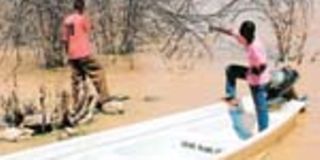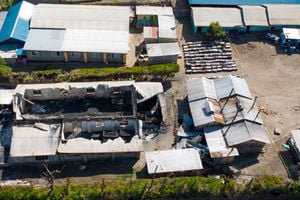Exotic plant choking Lake Baringo

Massive siltation and the subsequent water recession are choking Lake Baringo and killing the once flourishing fishing industry.
The situation has been aggravated by the invasion of the shoreline by the fast-spreading thorny Prosopis juliflora plant that was introduced in the country to curb desertification but has taken a life of its own and is making life almost unbearable for the local farming and pastoralist communities.
Masses of the dead thorny twigs and branches are being washed into the lake by flash floods, aggravating the already bad siltation problem.
Livestock that feed on the pods of the plant lose their teeth through severe chipping and finally die when they are unable to feed any more. The sharp, sturdy thorns give a nasty prick that requires one to seek medical treatment.
Fishermen who have been pricked by the thorns as they pushed their boats into the water showed scars of wounds they said took long to heal.
"The plant is colonising the entire region now and is spreading to Turkana district," said Mr Murray Roberts, a coordinator of the Rehabilitation of Arid Environments (RAE) Charitable Trust that is based at Kampi Ya Samaki, on the shores of Lake Baringo.
A Nakuru farmer is said to have introduced other environmentally friendly species of the plant - Prosopis chilensis in Coast Province a few decades ago ostensibly to create forage for bees. The Chilean species became a success and contributed in increased amounts of honey harvested in the areas it was planted.
But in the Rift Valley, locals can no longer control Prosopis juliflora, said to have been imported from Australia and India with the support of donors.
Although RAE has helped reclaim more than 4,000 acres of the severely degraded semi-arid land in the neighbourhood of Lake Baringo, the organisation's efforts to curb the lake's siltation are greatly hampered by the vast deforestation that has been taking place, far away in the Mau Forest where River Molo rises.
Flash floods also wash tonnes of silt into the lake from the Tugen Hills, Kabarnet, Kipcherere and Sabor.
The silt has, apart from filling up the lake floor, damaged the fish-breeding habitat, resulting in a drastic drop in fish stocks.
The Department of Fisheries says that fish landing has dropped from 1,200 tonnes to 600 tonnes annually during the last few years.
The food-chain disturbance has affected crocodiles in the lake that they are now attacking sheep and goats frequently due to the decline of fish stocks.
Mr Roberts said the crocodiles killed a primary school pupil and injured several other residents in the recent past, something that never occurred when the lake teemed with various fish species that include Tilapia, Protopterus, Clarias, Barbus, Common Carp and Labeo.
About 300 fishermen depended on the lake for their livelihood in the early 90s but today only a handful compete with crocodiles for the remaining stocks.
The lake covered about 146 square kilometres in the early 80s but almost 30 square kilometres have since been lost due to siltation.
Mr Roberts says that the lake's average depth in 1971 was about 10 metres but measurements taken in 1996 showed it was only 4.22 metres deep.
In 2003, the average depth was estimated at only1.22 metres and 2.54 metres in September last year.
Villagers living in Ol Kokwe Island can now sell their cattle on the hoof at Kampi Ya Samaki Trading Centre because the animals are able to swim in the shallow waters while merchants drive them using simple boats made of balsa tree stems.
Apart from River Molo, other rivers that discharge water in Lake Baringo include Perkerra whose flow is greatly reduced by the irrigation projects at Marigat, Endao and Arabal. Some of these rivers are seasonal and, therefore, unreliable.
Mr Roberts believes that the lake can be saved with the introduction of proper farming practices in the catchment areas, coupled with afforestation programmes in the Mau Forest, which is the source of many rivers.
RAE, he says, has introduced more than 50 tree species and 40 different grasses around Lake Baringo. This has contributed to reducing soil erosion and has improved the livelihood of hundreds of people.
Examples of income generation from reclaimed land include the fattening of livestock for sale, renting land, selling grass seeds and hay and bee keeping.
Mr Roberts estimates that about 435,000 tree seedlings are planted in the area through the RAE programmes annually.
While most of the locals told Horizon they wanted the government to help them get rid of Prosopis juliflora, Mr Richard Choimet believes that the tree could still achieve its intended target of curbing desertification and soil erosion.
Mr Choimet said that the "unwanted" tree had introduced a rare green beauty in the lowlands of Baringo and was now the main source of fuel wood and charcoal.
"The tree is effective in checking soil erosion by both water and wind and we think it will significantly help to stop siltation in Lake Baringo," he said.
He said swarms of bees had migrated to the lowlands now being colonised by the Prosopis juliflora owing to the abundance of nectar.
Mr Choimet suggested that the National Environment Management Authority (Nema) and other research organisations establish if the leaves and pods of the plant could be used to manufacture animal feeds.
"Residents should for now be advised to prune the Prosopis juliflora trees and uproot the undergrowths that are chocking other vegetation. I believe that this plant could save Lake Baringo but let us hear from Nema and other experts before condemning it wholesale," said Mr Choimet.
Mr William Cliff Kiror, a bird-watch guide around Lake Baringo, agrees that bird species have increased since Prosopis juliflora plant was introduced.
"We have more than 450 bird species around Lake Baringo, many of which were not here before the plant was introduced," said Mr Kiror said.




